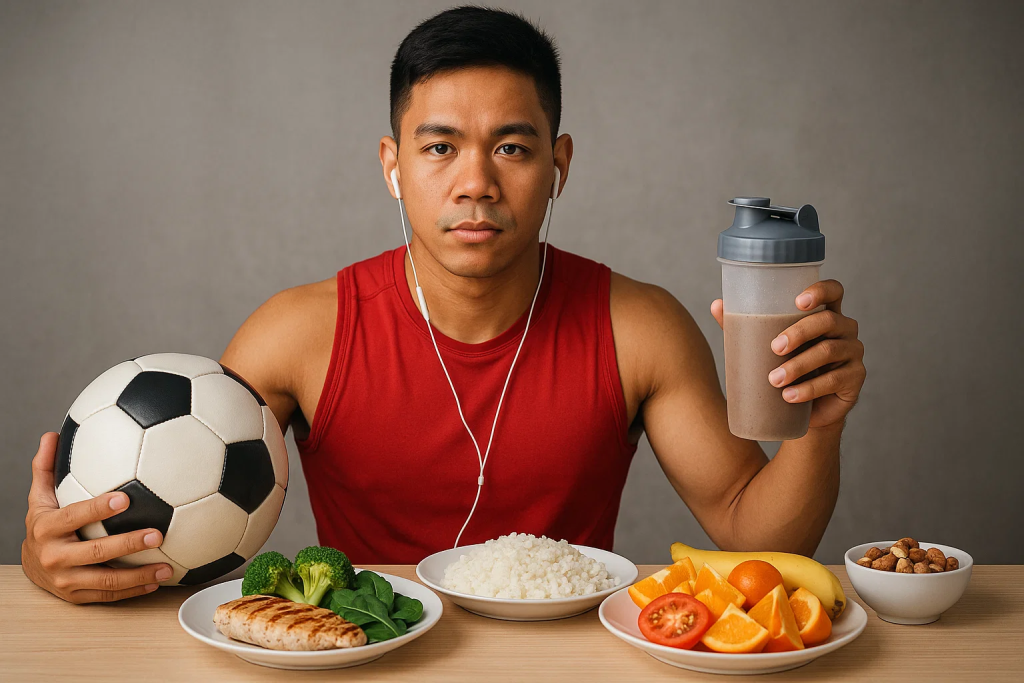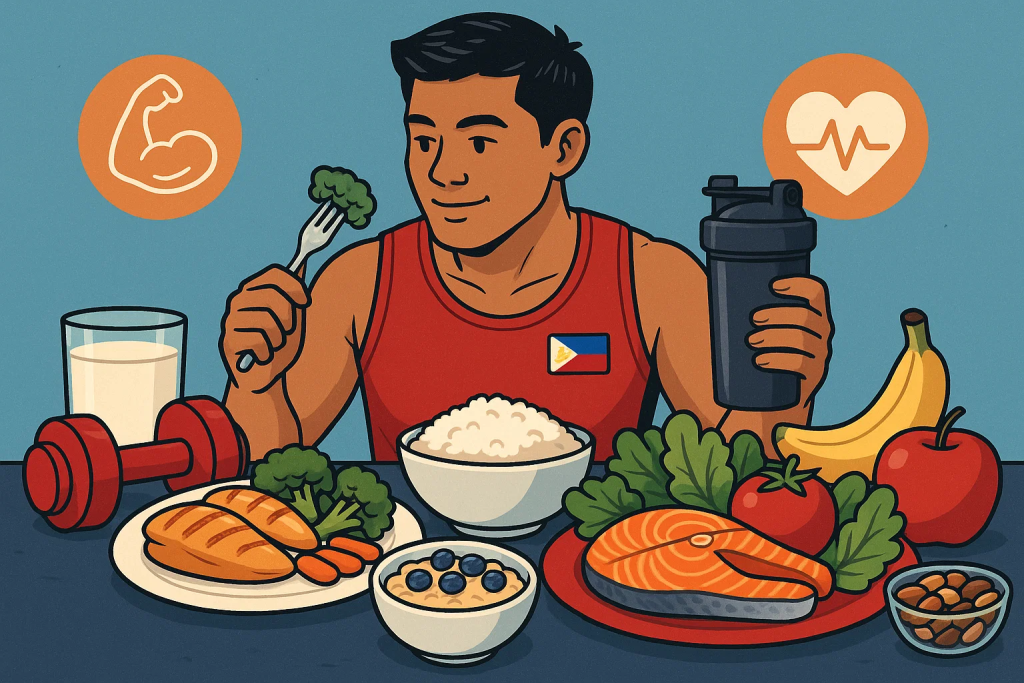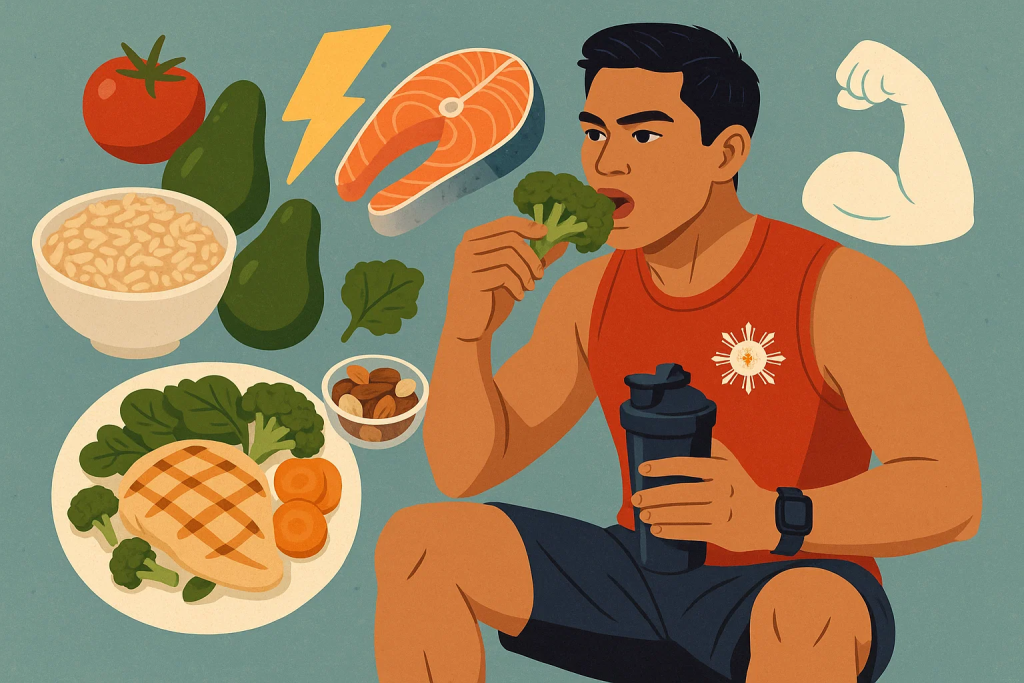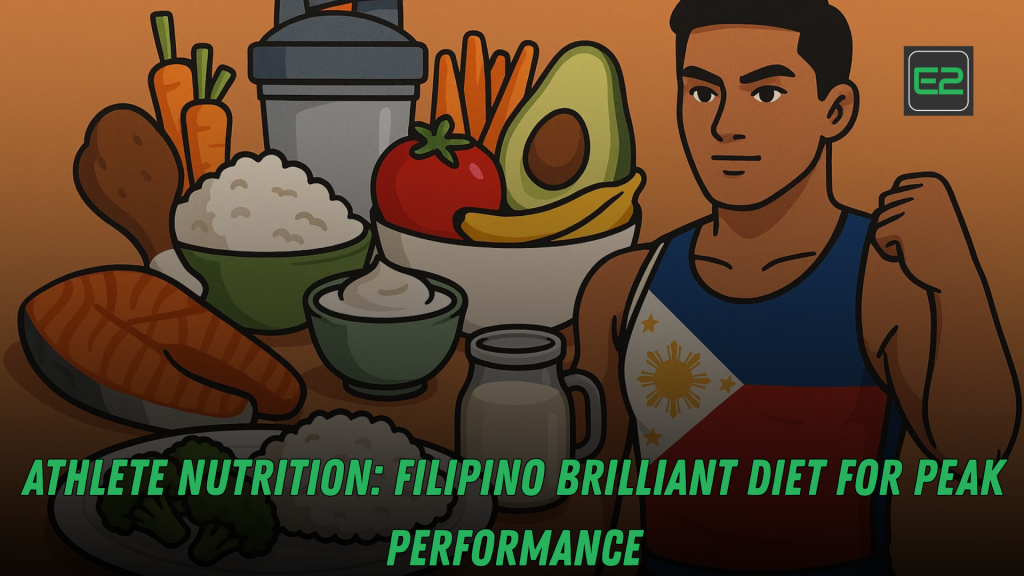Table of Contents
Why read this guide
Filipino food can be delicious and performance-driven. With smart tweaks, everyday staples—kanin, isda, gulay, saging, gata, monggo—can power elite training blocks, recovery, and competition days. This guide distills sports-nutrition best practices into Filipino flavors, with practical menus, timing strategies, hydration in tropical heat, budget shopping, and supplement basics. It’s built for endurance athletes, strength/power sports, court and field games, and weight-class competitors.
Quick disclaimer: This is educational content—not medical advice. If you have a condition (e.g., diabetes, kidney, GI issues), or compete under strict anti-doping rules, consult a Registered Nutritionist-Dietitian (RND) and your sports physician.

Key takeaways (skim-friendly)
- Build your plate by training load, not by trends. On heavy days, prioritize carbs; on light days, emphasize veggies, protein, and healthy fats.
- Carb targets: ~3–7 g/kg/day for moderate training; 6–10 g/kg/day for endurance phases or tournaments.
- Protein: 1.6–2.2 g/kg/day split across 3–5 meals/snacks supports muscle repair and adaptation.
- Fats: ~0.8–1.0 g/kg/day from quality sources (isda, itlog, mani, abokado, niyog).
- Hydration in the tropics is performance-critical: baseline 30–40 ml/kg/day plus electrolytes; use body-mass change to gauge sweat losses.
- Use Filipino dishes to meet timing windows: lugaw + itlog pre-session, bananas + isotonic during, sinigang + rice after.
- Consider evidence-backed supplements (creatine, caffeine, beta-alanine) only if diet is sound and products are third-party tested.
- A budget-smart palengke list and sari-sari store picks can fuel high performance without luxury groceries.
The Filipino advantage: culturally familiar, physiologically smart
A winning nutrition plan is the one you’ll actually follow. Filipino cuisine brings built-in strengths:
- Carb variety for training periodization
Rice (jasmine, dinorado, brown, red), corn, camote, saba, oats, pancit noodles—easy to scale up or down based on session load. - Marine proteins for recovery
Bangus, tilapia, galunggong, tuna, tahong, pusit—rich in complete protein and omega-3s (anti-inflammatory support). - Micronutrient-dense veg & herbs
Malunggay, kangkong, talbos ng kamote, ampalaya, pechay, kalabasa, sayote, calamansi, luya—great for iron, folate, potassium, vitamin C, phytochemicals. - Coconut-based fats for energy and mouthfeel
Gata adds calories and palatability—use strategically on medium/light days; keep portions mindful around weigh-ins. - Tropical fruits for rapid carbs + potassium
Saging, pinya, mangga, pakwan, papaya—ideal around sessions and for hydration synergy.
The Performance-Plate method (Filipino edition)
Visual guides beat calorie math in the middle of a training week. Use these plate splits to adjust per session load.
Light/Recovery day (technique, mobility, deload)
- ½ plate non-starchy veg (kangkong, talbos, ampalaya, pechay)
- ¼ plate protein (isda, manok, tokwa, lean pork/beef)
- ¼ plate carbs (kanin—brown/half-rice, camote, monggo)
- 1 tsp oil or a small gata drizzle, fruit for dessert
Moderate day (regular practice or gym)
- ⅓ plate carbs (white rice, pancit bihon/canton, camote)
- ⅓ plate protein
- ⅓ plate veggies + fruit
- Electrolytes if training in heat >60 minutes
Heavy day / Two-a-days / Tournament day
- ½ plate carbs (white rice, pasta, pandesal, oatmeal)
- ¼ plate protein
- ¼ plate veg
- Add easy-to-digest fruit (saging, pinya), and limit hard-to-digest fats pre-session
Macro targets by goal
Start at the low end if you’re new, adjust weekly using body-mass, energy, sleep, and session quality.
- Carbs
- Skill/strength base: 3–5 g/kg/day
- Court/field moderate: 5–7 g/kg/day
- Endurance block: 6–10 g/kg/day (use drink mixes, rice, fruit, rice cakes)
- Protein: 1.6–2.2 g/kg/day, evenly distributed (0.3–0.4 g/kg per meal)
- Fat: 0.8–1.0 g/kg/day (don’t drop below ~0.6 g/kg for hormones)
Micronutrients to watch (Filipino sources):
- Iron: baka na lean, atay (occasionally), tahong, kangkong; pair with calamansi for vitamin C to aid absorption.
- Calcium: dilis (with bones), gatas/fortified soy, tokwa, malunggay.
- Magnesium & potassium: monggo, saging, talbos, kalabasa.
- Iodine: iodized salt (especially if you rarely eat seaweed).
- Vitamin D: sunlight (safe exposure) or dietitian-guided supplementation if deficient.
Hydration & electrolytes in a hot, humid climate
Baseline: ~30–40 ml/kg/day fluids.
Pre-session (2–4 h): 5–7 ml/kg water/electrolyte.
During: Aim 150–250 ml every 15–20 minutes; add electrolytes if session >60–75 minutes or sweat is salty.
Post: Replace ~150% of fluid lost (if you drop 1 kg during training, drink ~1.5 L over the next 2–4 h), include sodium to retain fluids.
DIY Filipino electrolyte mix (750 ml bottle):
- Water + 1–2 tbsp calamansi/pineapple juice
- 1–2 tsp honey or sugar
- ¼ tsp iodized salt (can adjust to taste)
- Ice; shake well
Track sweat rate: weigh before/after (same clothes, towel off). Each 1 kg loss ≈ 1 L fluid deficit.

Nutrient timing—Filipino foods that fit
2–4 hours pre-training
- Good carbs + moderate protein + low fat/fiber
- Chicken adobo (lean) + 1–1.5 cups white rice + pechay sauté
- Tuna pasta (olive oil light) + side fruit
- Tinola + rice + mangga (small)
30–60 minutes pre-training
- Easily digested carbs
- Pandesal + banana
- Lugaw with egg (light portion)
- Oats + calamansi honey water
During (if >60–90 minutes, moderate-hard)
- 30–60 g carbs/hour
- Saging na saba, sports drink, rice balls (suman mini pieces), diluted pineapple juice + pinch of salt
Post-training (within 30–60 minutes)
- Carbs + 20–40 g protein + fluids + sodium
- Sinigang na hipon/manok + 1.5 cups rice + pakwan slices
- Ginisang monggo + tinapang isda + rice
- Tuna/Chicken “silog” (less oil) + fruit + electrolyte
Three sample 1-day menus used by Filipino (use as templates)
A) Endurance long-run / long-ride day (~7–9 g/kg carbs)
Breakfast (3–4 h pre-): Oatmeal with banana + peanut butter, 1 boiled egg; calamansi water
During: 2 bananas, 1–2 rice cakes, isotonic (600–1000 ml/h as needed)
Post: Chicken arroz caldo (large bowl) + extra rice balls; coconut water
Lunch: Sinigang na salmon belly (trim fat) + 2 cups rice + kangkong
Snack: Papaya + yogurt
Dinner: Inihaw na tilapia + garlic rice (1 cup) + talbos ng kamote salad
Pre-sleep: Milk or fortified soy + 1 pandesal
B) Strength/power day (~5–6 g/kg carbs; protein high)
Breakfast: Tapsilog (lean beef), 1 cup rice, ensalada; coffee
Snack: Banana + whey or tofu smoothie
Lunch: Adobo chicken breast, 1 cup rice, malunggay guisado
Pre-gym snack: Pandesal + jam; electrolyte sip
Post-gym: Tuna pasta (olive oil light) + fruit
Dinner: Pork loin sinigang (trimmed) + 1 cup rice + sayote
Pre-sleep: Cottage cheese/Greek yogurt or warm milk + cocoa
C) Weight-class athlete (maintenance, close to competition; carbs timed around training)
Breakfast: Tinola (brothy) + ¾ cup rice + mango slices
Snack: Rice crackers + tokwa skewers
Lunch (post-training): Ginisang monggo + inihaw na manok + 1 cup rice + banana
Snack: Papaya + nuts (small handful)
Dinner: Fish paksiw + pechay sauté + ½–¾ cup rice
Hydration: Water + electrolytes; avoid sugary drinks outside sessions
Note: In weigh-in week, manage fiber and sodium strategically with your RND/coach.
On-the-go Filipino snack matrix (by goal)
- Quick carbs (pre/during): banana, dried mango (small portion), rice crackers, suman bites, pandesal + jam
- Protein hits (post/anytime): tuna sachet, Greek yogurt, tokwa sticks, milk/fortified soy, chicken breast sandwich
- Balanced mini-meals: Arroz caldo cup, champorado with milk (light), pancit bihon veggie-heavy
- Electrolyte add-ons: calamansi + salt water, coconut water (diluted), sports drink powder
Budget-smart palengke & sari-sari strategy
Palengke priorities (₱-friendly + performance):
- Protein: Whole chicken (portion out), bangus/galunggong/tilapia, eggs, tahong, tofu/tokwa, monggo
- Carbs: Dinorado/jasmine rice (buy in bulk), camote, oats, bihon/canton
- Veg & fruit: Kangkong, talbos, pechay, kalabasa, sayote, saging, papaya, pinya
- Flavor & function: Kalamansi, luya, bawang, sibuyas; iodized salt; toyo/suka (moderate)
- Hydration: Powdered electrolyte or DIY ingredients (salt + sugar + citrus)
Sari-sari quick wins:
- Pandesal, crackers (check labels for lower saturated fat), banana, bottled water, powdered drink sachets (use half for light mix), milk boxes
Batch cooking ideas (Sunday prep):
- 2 kg chicken adobo (lean) → portion for 5 lunches
- Ginisang monggo (big pot) → add different proteins mid-week
- Sinigang broth base → rotate fish/chicken/veggies
- Rice in bulk → cool and store safely; reheat as needed
Gut training & heat strategies (zero GI drama on game day)
- Practice your race fuel (bananas, rice cakes, drinks) in training, not on competition day.
- Fiber control within 12–24 h pre-event if you’re GI-sensitive; choose white rice, ripe bananas, broth soups.
- Spice & fat: minimize in the last pre-event meal to reduce reflux.
- Cold fluids and ice slurries can reduce thermal strain in extreme heat.
- Sodium: if you’re a salty sweater (white marks on cap/shirt), favor saltier broths or add a pinch of salt to drinks close to hard efforts.
Special considerations
Female athletes
- Track iron status (fatigue, pallor, frequent headaches warrant a check). Lean red meat 1–2×/week, tahong, kangkong + vitamin C pairing.
- Calcium and vitamin D: dairy or fortified alternatives + safe sun.
- Energy availability: avoid chronic low intake (REDs risk). Work with an RND if menstrual changes occur.
Vegetarian/plant-forward Pinoy plate
- Protein rotation: tokwa/tempeh, monggo, peanuts, adlai + soy, eggs (if ovo-).
- Iron & zinc boosters: monggo + calamansi; pair legumes with vitamin C sources.
- B12: fortified foods or supplement if fully plant-based (under pro guidance).
Halal or pescatarian options
- Prioritize isda/hipon/tahong, chicken cuts with halal certification, plant proteins; avoid hidden animal fats in sauces.
Weight-class sports (boxing, MMA, weightlifting)
- Periodize carbs; protect protein; don’t slash fluids recklessly.
- In final week: coordinate fiber/sodium manipulation and weigh-in fueling with your RND coach to avoid dangerous rapid cuts.
Supplements that can help (if—big if—your diet is solid)
Always use third-party tested products (e.g., NSF Certified for Sport/Informed Sport) to minimize contamination risk.
- Creatine monohydrate: 3–5 g/day supports strength, power, repeat sprints. Possible mild water weight—time its use around weigh-ins.
- Caffeine: ~3 mg/kg 30–60 min pre-session can improve alertness/endurance. Avoid late-day doses if sleep suffers.
- Beta-alanine: 3–6 g/day split doses for 4–8 weeks; helps with 1–4 minute high-intensity efforts (tingling is normal).
- Nitrates (food first): beetroot, pechay, mustasa, kangkong; may aid endurance.
- Omega-3: if fish intake is low, consider under guidance.
- Vitamin D: test-and-treat if deficient.
- Probiotics: may help some athletes’ GI comfort; strain-specific.
Skip the hype: Proprietary blends with huge claims, “fat burners,” or unverified herbs aren’t worth anti-doping or health risks.
Travel & tournament logistics (Filipino bento mindset)
- Packable staples: pandesal, rice balls, tuna pouch, banana, electrolyte sticks, nuts, yogurt (if chilled).
- Scouting food near venue: broth soups, grilled fish/chicken, rice/veggies; avoid deep-fried mystery meats before events.
- Food safety: when in doubt, hot and fresh beats buffet that sat for hours.
- Sleep first: nutrition works best on 7–9 hours/night. Use decaf later in the day; consider a small carb-protein snack pre-bed if you trained late.
Progress tracking that isn’t toxic
- Weekly check-ins: mood, energy, training quality, soreness, sleep (1–5 rating).
- Body mass: 1–2×/week first thing in the morning; look for trends, not daily noise.
- Performance markers: times, reps, perceived exertion (RPE).
- Food journal (brief): note pre-session meals that consistently feel great vs. heavy.
10 Filipino performance meals (copy-paste rotation)
- Tinola + rice + mangga (light, pre-training)
- Sinigang na hipon + 2 cups rice (post-long run)
- Ginisang monggo + inihaw na manok (recovery)
- Tuna pasta (olive oil light) + pinya (post-gym)
- Chicken arroz caldo + egg + calamansi (tournament morning)
- Bangus belly (trim) + garlic rice + talbos salad (strength day dinner)
- Paksiw na isda + pechay + ¾ cup rice (maintenance)
- Tokwa’t gulay stir-fry + adlai/rice (plant-forward)
- Oats + banana + peanut butter + milk (early pre-session)
- Pandesal tuna melt (lite) + fruit (travel day)

Strong call-to-action (CTA)
Ready to build your Filipino Brilliant Diet for peak performance?
- Comment with your sport, training schedule, and biggest fueling hurdle (heat, GI, budget, timing). I’ll reply with a tailored Performance Plate and snack ladder suggestion.
- Want a printable 1-page checklist (hydration math, timing windows, palengke list, travel kit)? Reply “SEND THE CHECKLIST” and I’ll share the PDF template.
FAQs (Filipino Brilliant Diet)
1) Kailangan ba ng supplements para maging elite?
Hindi. Food first wins most of the time. Kapag maayos na ang plate timing, hydration, at protein/carb targets, saka lang isaalang-alang ang creatine, caffeine, o beta-alanine gamit ang third-party tested brands—at kung tugma sa sport mo.
2) Okay ba ang white rice para sa atleta?
Oo. Sa heavy/moderate days, white rice is ideal fuel—madaling tunawin at mabilis i-convert to glycogen. Gamitin ang brown/red rice o camote sa light/recovery days para dagdag fiber at satiety.
3) Paano ko maiiwasan ang cramps at GI issues sa init?
Practice electrolyte strategy (sodium + fluids), use ripe bananas/rice cakes for during-training carbs, at iwasan ang sobrang mantika at spicy food pre-event. Train your gut—kung ano ang dala mo sa competition, i-practice mo sa long sessions.
4) Vegetarian ako—kaya bang ma-hit ang protein?
Kaya, pero planado: tokwa/tempeh, monggo + rice (complementary proteins), itlog (kung ovo-), dairy/fortified soy, at shakes kung kailangan. Target 1.6–2.2 g/kg/day, spread across 3–5 feedings.
5) Paano kung tight ang budget?
Palengke > specialty store. Piliin whole chicken cuts, bangus/galunggong, eggs, monggo, seasonal gulay, saging, papaya, bulk rice. Batch-cook adobo (lean), monggo, sinigang; gumamit ng DIY electrolyte (water + calamansi + ¼ tsp salt + 1–2 tsp sugar).
You don’t need imported meal kits to eat like a champion. With a performance-first mindset and the flavors you grew up with, the Filipino Brilliant Diet can carry you from weekday practice to podium day—strong, fueled, and proud.
